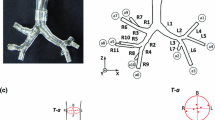Abstract
We used computational fluid dynamics to study airflow characteristics in the space between the bulla and the middle turbinate (Region P1) and the superior meatus (Region P2) of the human upper airway, which exhibit intermittent flow separation. For comparison, we examined airflow passage in the inferior meatus (Region N), where large-scale flow separation develops. We assessed six different flow rates, based on realistic human respiration data representing one full period of respiration, in an anatomically correct numerical model. The simulation results showed that airflow in regions P1 and P2 had a relatively smaller separation bubble with a larger variation of bubble size with time, whereas region N exhibited a more gradually changing, two-dimensional rotation-like motion. Distinctive features of flow characteristics in regions P1 and P2 were relatively low Reynolds number, higher curvature of streamlines of the local main flow, with the existence of locations exhibiting intermittent occurrence of relatively quite high level of wall shear during inspiration.
Similar content being viewed by others
References
R. Eccles, Nasal airflow in health and disease, Acta Oto-Laryngologica, 120 (5) (2000) 580–595.
S. K. Kim, Y. Na, J. I. Kim and S. K. Chung, Patient-specific CFD models of nasal airflow: Overview of methods and challenges, J. of Biomechanics, 46 (2013) 299–306.
D. J. Doorly, D. J. Taylor and R. C. Schroter, Mechanics of airflow in the human nasal airways, Respiratory Physiology & Nuerobiology, 163 (2008) 100–110.
O. Abouali, E. Keshavarzian, P. F. Ghalati, A. Faramarzi, G. Ahmadi and M. H. Bagheri, Micro and nanoparticle deposition in human nasal passage pre and post virtual maxillary sinus endoscopic surgery, Respiratory Physiology & Nuerobiology, 181 (2012).
C. E. Rennie, C. M. Hood, E. J. S. M. Blenke, R. S. Schroter, D. J. Doorly, H. Jones, D. Towey and N. S. Tolley, Physical and computational modeling of ventilation of the maxillary sinus, Otolaryngology-Head and Neck Surgergy, 145 (2011) 165–170.
S. K. Chung, G. Jo and Y. Na, Investigation of flow characteristics in regions of nasal polypoid change, Computers in Biology and Medicine, 70 (2016) 148–156.
D. Elad, M. Wolf and T. Keck, Air-conditioning in the human nasal cavity, Respiratory Physiology & Nuerobiology, 163 (2008) 121–127.
P. Cole, Nasal airflow resistance: a survey of 2500 assessments, American J. of Rhinology, 11 (1997) 415–420.
S. K. Chung, D. W. Kim and Y. Na, Numerical study on the effect of uncinectomy on airflow modification and ventilation characteristics of the maxillary sinus, Respiratory Physiology & Nuerobiology, 228 (2016) 47–60.
D. L. Fry, Hemodynamic forces in atherogenesis, P. Steinberg (Ed.), In Cerebrovascular Diseases, Raven Press(1976) 77–95.
S. K. Chung, G. Jo, S. K. Kim and Y. Na, The effect of a middle meatal antrostomy on nitric oxide ventilation in the maxillary sinus, Respiratory Physiology & Neurobiology, 192 (2014) 7–16.
N. Mygind, R. Dahl and C. Bachert, Nasal polyposis, eosinophil dominated inflammation, and allergy, Thorax, 55 (2000) S79–S83.
H. Stammberger, Suregical treatment of nasal polyps: past, present, and future, Allergy, 54 (1999) 7–11.
P. Assanasen and R. M. Naclerio, Medical and surgical management of nasal polyps, Current Opinion in Otolaryngology & Head and Neck Surgery, 9 (2001) 27–36.
N. D. Bateman, C. Fahy and T. J. Woolford, Nasal polyps: Still more questions than answers, J. of Laryngology & Otology, 117 (2003) 1–9.
J. Murray and J. Nadel, Textbook of Respiratory Medicine, 3rd ed., Saunders, Philadelphia(2000).
Author information
Authors and Affiliations
Corresponding author
Additional information
Recommended by Associate Editor Simon Song
Gyehwan Jo received his M.S. degree in mechanical engineering from Konkuk University, Korea. His research interest is in computational fluid dynamics and biomechanics.
Yang Na received his B.S. and M.S. degrees in mechanical engineering from Seoul National University, Korea and Ph.D. degree from Stanford University, U.S.A. His research interest is in computational fluid dynamics and biomechanics.
Rights and permissions
About this article
Cite this article
Jo, G., Na, Y. Investigation of flow characteristics in regions of intermittent formation of flow separation inside the nasal cavity. J Mech Sci Technol 31, 2351–2357 (2017). https://doi.org/10.1007/s12206-017-0431-7
Received:
Revised:
Accepted:
Published:
Issue Date:
DOI: https://doi.org/10.1007/s12206-017-0431-7




